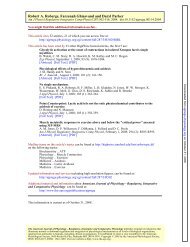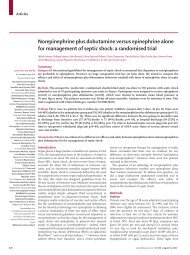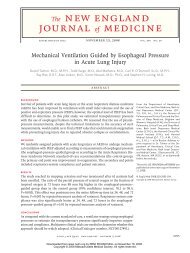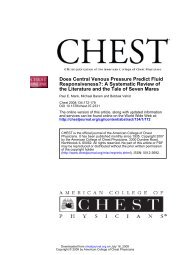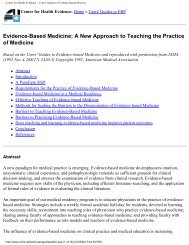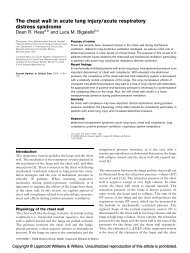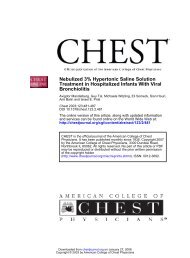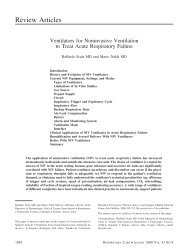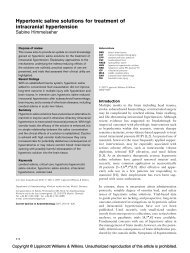SMART-COP: A Tool for Predicting the Need for Intensive ...
SMART-COP: A Tool for Predicting the Need for Intensive ...
SMART-COP: A Tool for Predicting the Need for Intensive ...
You also want an ePaper? Increase the reach of your titles
YUMPU automatically turns print PDFs into web optimized ePapers that Google loves.
Table 1.Characteristics of validation cohort studies.Characteristic PORT [3] CAPO [21] Austin [22] EDCAP [23] LOS [24]Location USA and Canada Global Melbourne, Australia CT and PA Pittsburgh, PADates Oct 1991–Mar 1994 Jan 2001–Dec 2006 Jan–Dec 2002 Jan–Dec 2001 Feb 1998–Mar 1999Inclusion criteria Age 18 years; 1 symptomof CAP; CXR changesAge 18 years; 1 symptomof CAP; CXR changesAge 18 years; 1 symptomof CAP; CXR changesAge 18 years; CAP diagnosis;CXR changesAge 18 years; CAP diagnosis;CXR changesExclusion criteria Admitted within preceding 10days; HIV infected… Admitted within preceding 14days; hospital stay !24 h;aspiration-active tuberculosis;HIV infectedHospital-acquired infection; immunosuppression;cystic fi-days; HIV infected; cystic fi-Admitted within preceding 10brosis; active tuberculosis; brosis; active tuberculosis;o<strong>the</strong>r a o<strong>the</strong>r bNOTE. CAP, community-acquired pneumonia; CAPO, Community-Acquired Pneumonia Organization; CXR, chest radiography; EDCAP, Emergency DepartmentCAP trial; LOS, Length of Stay Project; PORT, Pneumonia Patient Outcomes Research Team.a O<strong>the</strong>r exclusion criteria were substance abuse, poor psychosocial circumstances that precluded outpatient <strong>the</strong>rapy, incarceration, homelessness, andpregnancy.b O<strong>the</strong>r exclusion criteria were immunosuppression (i.e., HIV infection, WBC count ! 3000 cells/mm 3 , asplenia, hypogammaglobulinemia, use of myelosuppressivemedications, corticosteroid use, or organ transplantation), injection drug use, alcohol abuse, or receipt of only palliative care.features is converted into a score that indicates <strong>the</strong> patient’srisk of death and can be used to guide <strong>the</strong> choice of inpatientversus outpatient care. Although 30-day mortality is clearly animportant outcome, <strong>the</strong> vast majority of patients who die ofCAP are elderly persons with multiple comorbidities [5, 6].When such patients are admitted to <strong>the</strong> hospital, aggressivetreatment in <strong>the</strong> intensive care unit (ICU) is often consideredinappropriate, given <strong>the</strong>ir poor quality of life and prognosis[7]. Thus, tools that are accurate in predicting mortality areless accurate <strong>for</strong> identifying patients likely to benefit from admissionto <strong>the</strong> ICU [8–12].The ability to predict which patients will require ICU admissioncan be difficult because clinicians both overestimateand underestimate <strong>the</strong> severity of CAP [13, 14]. Patients whorequire ICU admission consume a large proportion of healthcare expenditure [2, 15]. Early recognition of such patientscould improve outcomes, avoid inappropriate nonadmissions,and potentially lead to a shorter length of ICU stay.Because criteria <strong>for</strong> ICU admission vary both between hospitalsand between countries, we aimed to assess features specificallyassociated with receipt of intensive respiratory orvasopressor support (IRVS; i.e., invasive or noninvasive mechanicalventilation or infusions of vasopressors <strong>for</strong> blood pressuresupport), ra<strong>the</strong>r than simple ICU admission, because <strong>the</strong>seare likely to be objective markers of CAP severity across institutionsand health care systems.The Australian Community-Acquired Pneumonia Study(ACAPS) was a prospective, multicenter, observational studythat assessed <strong>the</strong> etiology, severity markers, and treatment outcomesof a large population of patients with CAP defined bystrict criteria [16]. We used <strong>the</strong>se data to develop a new toolto identify patients with CAP who require IRVS.METHODSStudy design and setting. Patient recruitment and <strong>the</strong> inclusionand exclusion criteria have been described elsewhere [17];<strong>the</strong> only difference <strong>for</strong> this aspect of <strong>the</strong> study is that pregnantpatients were excluded from analysis. The following patientdetails were recorded: demographic characteristics, comorbidillnesses, initial vital signs, and <strong>the</strong> various investigational resultsrequired to calculate PSI [3] and CURB-65 [4] scores. In calculating<strong>the</strong> PSI score, we allowed <strong>the</strong> use of pulse oximetryscores 90% to obtain <strong>the</strong> 10 points <strong>for</strong> hypoxia [3] and <strong>the</strong>use of pH from a venous blood sample (30 points <strong>for</strong> venouspH !7.30) if arterial puncture was thought to be inappropriate,because this correlates with arterial acidosis [18]. On <strong>the</strong> basisof CURB-65 scores, patients were classified into CURB-65group 1 (scores 0–1), group 2 (score 2), and group 3 (scores3–5) [4]. In addition, we recorded o<strong>the</strong>r comorbidities (smokingstatus, asthma, chronic obstructive pulmonary disease[<strong>COP</strong>D], diabetes mellitus, alcohol abuse, injection drug use,neuromuscular conditions, epilepsy, or dementia), oral antibioticand corticosteroid use be<strong>for</strong>e hospitalization, vital signsat <strong>the</strong> time of arrival and <strong>the</strong> worst results (e.g., highest respiratoryrate and lowest blood pressure) in <strong>the</strong> first 24 h, o<strong>the</strong>rinitial laboratory results (including WBC count, serum albuminlevel, erythrocyte sedimentation rate, and C-reactive proteinlevel), and results of urinary antigen tests <strong>for</strong> Legionella infection(Binax). The number of pulmonary lobes involved and<strong>the</strong> presence of pleural effusions were assessed on chest radiography.Blood culture specimens were obtained be<strong>for</strong>e parenteraladministration of antibiotics.In <strong>the</strong> hospital, patients were assessed <strong>for</strong> time to clinicalstability [19], admission to <strong>the</strong> ICU (including <strong>the</strong> high dependencyunit or coronary care unit), and length of hospitalstay. In particular, we recorded <strong>the</strong> receipt of IRVS as a moreobjective marker of severity than simple ICU admission. At 4–6 weeks after admission, patients were assessed <strong>for</strong> cure and<strong>for</strong> 30-day mortality.Statistical analysis and development of <strong>the</strong> severity predictiontool. Univariate analysis was per<strong>for</strong>med using logisticregression to explore associations between patient characteristicsand clinical features at <strong>the</strong> time of admission and <strong>the</strong> riskof subsequent receipt of IRVS. For multivariate analyses, a pre-376 • CID 2008:47 (1 August) • Charles et al.
Table 2. Baseline characteristics of patients experiencingepisodes of community-acquired pneumonia (CAP) in<strong>the</strong> Australian CAP Study.CharacteristicNo. (%)of episodes aAge 50 years 213 (24.1)Male sex 537 (60.9)Nursing home resident 55 (6.2)Aboriginal ethnicity 10 (1.1)Site of enrollmentAustin Health 401 (45.5)Princess Alexandra Hospital 203 (23.0)The Alfred Hospital 159 (18.0)West Gippsland Hospital 45 (5.1)Monash Medical Centre 43 (4.9)Royal Perth Hospital 31 (3.5)Patient comorbiditiesCongestive cardiac failure 211 (23.9)Cerebrovascular disease 118 (13.4)Malignancy 42 (4.8)Renal impairment 169 (19.2)Liver disease 31 (3.5)Smoking 180 (20.4)Asthma 231 (26.2)<strong>COP</strong>D 238 (27.0)Alcohol abuse 48 (5.4)Injection drug use 17 (1.9)Diabetes mellitus 159 (18.0)Dementia 73 (8.3)Epilepsy 23 (2.6)Neuromuscular disease 25 (2.8)Immunosuppression b 84 (9.5)CAP-related characteristicsAntibiotic use be<strong>for</strong>e presentation 270 (30.6)Confusion 90 (10.2)Respiratory rate 30 breaths/min 195 (22.1)Tachypnea c 229 (26.0)Systolic BP !90 mm Hg 47 (5.3)Diastolic BP 60 mm Hg 289 (32.8)Pulse 125 beats/min 144 (16.3)Pulse oximetry 90% 231 (26.2)Arterial pH !7.35 79/511 (15.5)PaO 2 !60 mm Hg 220/511 (43.1)PaO 2 /FiO 2 !250 197/511 (38.6)Hypoxia d 406 (46.0)Hematocrit !30% 34 (3.9)WBC count !4 or115 10 9 cells/L 305 (34.6)ESR 150 266/581 (45.8)Sodium level !130 mmol/L 102 (11.6)Urea level 17 mmol/L 380 (43.1)Urea level 11 mmol/L 174 (19.7)Glucose level 14 mmol/L 47/800 (5.9)Albumin level !3.5 g/dL 455/853 (53.3)C-reactive protein level 1150 mg/L 414/853 (48.5)Multilobar CXR involvement 101 (11.5)Pleural effusion 147 (16.7)Positive result of Legionella urinary antigen test 19/847 (2.2)Admitted to ICU, HDU, or CCU 118 (13.4)Received ventilation 81 (9.2)Received vasopressor support 42 (4.8)(continued)Table 2.Characteristic(Continued.)No. (%)of episodes aDied in <strong>the</strong> hospital 41 (4.6)Died within 30 days after admission 50 (5.7)Severity scorePSI classI 109 (12.4)II 139 (15.8)III 160 (18.1)IV 301 (34.1)V 173 (19.6)CURB-65 group1 405 (45.9)2 238 (27.0)3 239 (27.1)NOTE. BP, blood pressure; CCU, coronary care unit; <strong>COP</strong>D,chronic obstructive pulmonary disease; CURB-65, tool based on confusion,urea level, respiratory rate, BP, and age 65 years; CXR, chestradiography; ESR, erythrocyte sedimentation rate; FiO 2 , fraction ofinspired oxygen; HDU, high dependency unit; ICU, intensive care unit;PaO 2 , partial pressure of oxygen; PSI, pneumonia severity index; SpO 2 ,arterial oxygen saturation.a Denominator is 882 total episodes of CAP, unless o<strong>the</strong>rwisespecified.b Immunosuppression that did not meet <strong>the</strong> exclusion criteria—that is, patients taking 10 mg of prednisolone, patients after undergoingsplenectomy, or patients who had received autologous stemcell transplant years earlier.c Age-adjusted tachypnea was defined as a respiratory rate 30breaths/min <strong>for</strong> patients aged 150 years and 25 breaths/min <strong>for</strong>patients aged 50 years.d Age-adjusted hypoxia was defined as ei<strong>the</strong>r PaO 2 !60 mm Hg,SpO 2 90%, or PaO 2 /FiO 2 !250 <strong>for</strong> patients aged 150 years and ei<strong>the</strong>rPaO 2 !70 mm Hg, SpO 2 93%, or PaO 2 /FiO 2 !333 <strong>for</strong> patients aged50 years.liminary step of exploratory analysis was pursued in which <strong>the</strong>cohort was stratified on age 50 years; separate logistic regressionmodels were developed <strong>for</strong> older and younger patients,and a small number of different cutoff points were considered<strong>for</strong> each covariate. This was repeated with stratification on age!40 years. On <strong>the</strong> basis of <strong>the</strong>se exploratory analyses, definitionsof high respiratory rate and hypoxia differed <strong>for</strong> patients aged150 years and those aged 50 years, and this concurred witha priori clinical expectations. For patients aged 50 years,tachypnea was defined as a respiratory rate 25 breaths/min;<strong>for</strong> patients aged 150 years, it was defined as 30 breaths/min.Hypoxia was defined as partial pressure of oxygen (PaO 2 ) !70mm Hg, PaO 2 divided by <strong>the</strong> fraction of inspired oxygen (PaO 2 /FiO 2 ) !333, or arterial oxygen saturation (SpO 2 ) 93% <strong>for</strong>patients aged 50 years and as PaO 2 !60 mm Hg, PaO 2 /FiO 2!250, or SpO 2 90% <strong>for</strong> patients aged 150 years. It was assumedthat patients without arterial pH measurements had anormal value [3].Multivariate logistic regression analyses of <strong>the</strong> features associatedwith receipt of IRVS were per<strong>for</strong>med using sex, age50 years, and all variables that had P ! .2 on univariate anal-<strong>Predicting</strong> <strong>the</strong> <strong>Need</strong> <strong>for</strong> IRVS in CAP • CID 2008:47 (1 August) • 377
Table 4. Univariate and multivariate analyses of features associated with receipt of intensive respiratory or vasopressorsupport.Risk factorUnivariateanalysisOR P OR PMultivariate analysisBeta coefficient(95% CI)Presence in1000 bootstrapreplications, %Demographic characteristicAge 50 years 1.1 .60 … … … 23 …Male sex 1.0 .89 … … … 18 …Nursing home resident 0.5 .23 … … … … …Comorbidity aAsthma 1.4 .12 … … … 53 …<strong>COP</strong>D 1.4 .18 … … … 37 …Smoking 1.9 .01 … … … 41 …Alcohol abuse 1.5 .32 … … … … …Injection drug use 3.8 .02 … … … … b …Diabetes mellitus 1.0 .86 … … … … …Renal impairment 1.3 .32 … … … … …Congestive cardiac failure 1.2 .56 … … … … …Stroke 1.0 .95 … … … … …Epilepsy 1.9 .27 … … … … …Neuromuscular disease 3.6 .01 … … … … b …Malignancy 0.9 .86 … … … … …Liver disease 2.2 .10 … … … … b …Immunosuppression c 1.7 .11 … … … 23 …Initial clinical characteristicConfusion (new) 3.9 !.001 1.9 .06 0.66 (0.04 to 1.35) 64 1Pulse 125 beats/min 2.9 !.001 2.1 .02 0.74 (0.12–1.35) 75 1Systolic BP !90 mm Hg 4.7 !.001 4.0 .002 1.38 (0.50–2.26) 83 2Diastolic BP 60 mm Hg 1.8 .009 … … … 14 …Tachypnea d 3.1 !.001 1.8 .03 0.60 (0.04–1.16) 68 1Temperature !35C or40C 1.3 .56 … … … … …Initial clinical findingArterial pH !7.35 16.2 !.001 11.8 !.001 2.47 (1.84–3.09) 100 2Hypoxia e 7.3 !.001 3.7 !.001 1.30 (0.67–1.93) 100 2Hematocrit !30% 2.4 .05 … … … … b …WBC count !4 or115 10 9 cells/L 1.6 .04 … … … 22 …Urea level 17 mmol/L 1.7 .02 … … … … …Urea level 11 mmol/L 1.8 .02 … … … 15 …Sodium level !130 mmol/L 1.6 .12 … … … 53 …Glucose level 14 mmol/L 2.4 .02 … … … … f …Albumin level !3.5 g/dL 2.5 !.001 2.8 .001 1.04 (0.45–1.63) 97 1C-reactive protein level 1150 mg/L 0.9 .68 … … … … …Positive result of Legionella urinary antigen test 3.2 .03 … … … … b …Multilobar CXR involvement 3.1 !.001 2.2 .02 0.78 (0.12–1.44) 69 1Pleural effusion 1.4 .26 … … … … …PointsassignedNOTE. BP, blood pressure; <strong>COP</strong>D, chronic obstructive pulmonary disease; CXR, chest radiography; FiO 2 , fraction of inspired oxygen; PaO 2 ,partial pressure of oxygen; SpO 2 , arterial oxygen saturation.a Comorbidities were defined as by Fine et al. [3].b Excluded from multivariate analysis because of prevalence 5%.c Immunosuppression that did not meet <strong>the</strong> exclusion criteria (i.e., patients taking 10 mg prednisolone, patients after splenectomy, orpatients who had received autologous stem cell transplant years earlier).d Age-adjusted tachypnea was defined as a respiratory rate of 30 breaths/min <strong>for</strong> patients aged 150 years and 25 breaths/min <strong>for</strong> patientsaged 50 years.e Age-adjusted hypoxia was defined as ei<strong>the</strong>r PaO 2 !60 mm Hg, SpO 2 90%, or PaO 2 /FiO 2 !250 <strong>for</strong> patients aged 150 years and ei<strong>the</strong>rPaO 2 !70 mm Hg, SpO 2 93%, or PaO 2 /FiO 2 !333 <strong>for</strong> patients aged 50 years.f Excluded from multivariate analysis because data were missing <strong>for</strong> 15% of patients.
Figure 1. Flow chart <strong>for</strong> <strong>the</strong> use of <strong>SMART</strong>-<strong>COP</strong>. BP, blood pressure; bpm, beats/min; br, breaths; CXR, chest radiography (x-ray); RR, respiratoryrate; yo, years old.level, respiratory rate, tachycardia, confusion, oxygenation, andarterial pH) (figure 1).A modified version of <strong>SMART</strong>-<strong>COP</strong> that is suitable <strong>for</strong> usein primary care settings was created by removing from <strong>SMART</strong>-<strong>COP</strong> <strong>the</strong> need <strong>for</strong> measurements of albumin level, arterial pH,and PaO 2 . The major criteria (2 points each) in this primarycare tool are low systolic blood pressure and hypoxia (basedon pulse oximetry results) (figure 1), and <strong>the</strong> minor criteria (1point each) are confusion, tachycardia, tachypnea, and multilobarchest radiography involvement. The first initials of <strong>the</strong>sefeatures were summarized in <strong>the</strong> mnemonic “SMRT-CO” (systolicblood pressure, multilobar chest radiography involvement,respiratory rate, tachycardia, confusion, and oxygenation).A <strong>SMART</strong>-<strong>COP</strong> score of 3 points identified 84 (92.3%) of91 patients who received IRVS. In comparison, a SMRT-COscore of 2 points identified 82 (90.1%) of <strong>the</strong> 91 patients.The sensitivities of all 4 tools (<strong>SMART</strong>-<strong>COP</strong>, SMRT-CO, PSI,and CURB-65) <strong>for</strong> predicting receipt of IRVS in <strong>the</strong> ACAPScohort are shown in table 5. Receiver operating characteristiccurves and AUCs <strong>for</strong> each tool are shown in figure 2. As shownin figure 3, an increasing <strong>SMART</strong>-<strong>COP</strong> score was associatedwith an increased rate of receipt of IRVS. An increasing scorewas also associated with higher mortality, and 42 (84%) of <strong>the</strong>50 patients who died had <strong>SMART</strong>-<strong>COP</strong> scores 3 points. A<strong>SMART</strong>-<strong>COP</strong> score 3 points had a positive predictive value(PPV) of 22.2%, and each subsequent 1-point increase in <strong>the</strong>score raised <strong>the</strong> PPV by ∼10% (data not shown).Of <strong>the</strong> 53 patients who received IRVS who were admitteddirectly to <strong>the</strong> ICU from <strong>the</strong> emergency department, a <strong>SMART</strong>-<strong>COP</strong> score 3 points accurately identified 52 (98.1%). Of <strong>the</strong>38 patients transferred from <strong>the</strong> emergency department to <strong>the</strong>general ward and later to <strong>the</strong> ICU, 32 (84.2%) had a <strong>SMART</strong>-<strong>COP</strong> score 3 points. Patients who received IRVS but had<strong>SMART</strong>-<strong>COP</strong> scores !3 all experienced significant clinical deteriorationat least 24–48 h after hospital admission; all but 1of <strong>the</strong>se patients received noninvasive ventilation.Validation of <strong>SMART</strong>-<strong>COP</strong>. Results of <strong>the</strong> external validationof <strong>SMART</strong>-<strong>COP</strong> are shown in table 6. Overall, AUC380 • CID 2008:47 (1 August) • Charles et al.
analysis indicated good discrimination <strong>for</strong> <strong>SMART</strong>-<strong>COP</strong> scores.There was no evidence of lack of fit in any database, indicatingthat <strong>the</strong> prediction probability of <strong>SMART</strong>-<strong>COP</strong> <strong>for</strong> IRVS appearedto be good. Never<strong>the</strong>less, <strong>the</strong>re were some limitationsin this validation analysis. Because results <strong>for</strong> respiratory rateand hypoxia were recorded as binary results in most of <strong>the</strong>sedatabases (i.e., above or below <strong>the</strong> relevant cutoff of <strong>the</strong> PSI),it was generally difficult to assess accurately <strong>the</strong> lower cutofflevels suggested by <strong>SMART</strong>-<strong>COP</strong> and SMRT-CO <strong>for</strong> <strong>the</strong>se variables<strong>for</strong> patients aged 50 years [3, 21, 23, 24]. Similarly,serum albumin level and arterial pH were recorded infrequentlyin <strong>the</strong> validation cohorts [3, 23, 24], and we followed <strong>the</strong> standardof assuming that patients with missing data had normalvalues [3]. This approach is likely to have resulted in a lowercalculated sensitivity <strong>for</strong> <strong>SMART</strong>-<strong>COP</strong> and may explain whySMRT-CO appeared to have similar sensitivity in those databases.Never<strong>the</strong>less, despite <strong>the</strong>se methodological differences in<strong>the</strong> CAP validation cohort studies, <strong>SMART</strong>-<strong>COP</strong> appeared tobe a sensitive and specific predictor of patients with CAP whoare likely to require IRVS.DISCUSSIONFigure 2. Area under <strong>the</strong> receiver operating characteristic curve (AUC)analysis <strong>for</strong> <strong>the</strong> 4 severity assessment tools. CURB-65, tool based onconfusion, urea level, respiratory rate, blood pressure, and age 65 years;PSI, pneumonia severity index.Current pneumonia severity assessment tools, such as PSI andCURB-65, aim to predict <strong>the</strong> likely 30-day mortality, but thisoutcome is heavily dependent on <strong>the</strong> patient’s age and comorbidillnesses, so <strong>the</strong>se tools may not necessarily predict <strong>the</strong>need <strong>for</strong> ICU admission or IRVS [8–12]. In fact, such featuresmay be important to clinicians in determining whe<strong>the</strong>r a patient’scase should be designated NFR and <strong>the</strong>re<strong>for</strong>e not appropriate<strong>for</strong> aggressive medical management. A <strong>SMART</strong>-<strong>COP</strong>score of 3 points better identified <strong>the</strong> majority of patientswho received IRVS than did PSI classes IV and V and CURB-65 group 3. <strong>SMART</strong>-<strong>COP</strong> was accurate both <strong>for</strong> patients whowent directly to <strong>the</strong> ICU from <strong>the</strong> emergency department (sensitivity,98%) and <strong>for</strong> those who were initially admitted to <strong>the</strong>general ward be<strong>for</strong>e <strong>the</strong>ir condition deteriorated (sensitivity,84%). Increasing <strong>SMART</strong>-<strong>COP</strong> scores were associated with anincreasing likelihood of requiring IRVS. Similarly, SMRT-CO,which does not require investigations beyond chest radiographyand pulse oximetry, also proved to be an accurate and simplesystem <strong>for</strong> identifying patients at a higher risk of severe disease,although less so than <strong>SMART</strong>-<strong>COP</strong>. Accuracy of both tools washigh <strong>for</strong> both <strong>the</strong> derivation and <strong>the</strong> validation cohorts. Theage-adjusted cutoffs <strong>for</strong> respiratory rate and hypoxia used in<strong>the</strong>se tools are particularly useful <strong>for</strong> <strong>the</strong> identification of younger,previously healthy patients with severe CAP. Such patientsare better able to increase tidal volume, instead of just respiratoryrate, and so may not achieve a rate of 30 breaths/mindespite having severe CAP. In addition, <strong>the</strong>ir PaO 2 must dropfur<strong>the</strong>r from baseline to reach !60 mm Hg, compared withthat of many elderly patients with preexisting respiratory orcardiac comorbidities.Although <strong>the</strong> PSI severity assessment tool is accurate in predicting30-day mortality, it is cumbersome and <strong>the</strong>re<strong>for</strong>e lessattractive <strong>for</strong> widespread use [25–27]. In addition, a patientcan be assigned to PSI class V on <strong>the</strong> basis of <strong>the</strong>ir age andTable 5.Comparison of <strong>the</strong> accuracy of assessment tools in predicting <strong>the</strong> receipt of intensive respiratory or vasopressor support.Score group Sensitivity (95% CI), % Specificity (95% CI), % PPV (95% CI), % NPV (95% CI), % AUC (95% CI)PSI classes IV and V 73.6 (63.3–82.3) 48.5 (45.0–52.1) 14.1 (11.1–17.6) 94.1 (91.4–96.2) 0.69 (0.63–0.74)CURB-65 group 3 38.5 (28.4–49.2) 74.2 (71.0–77.2) 14.6 (10.4–19.8) 91.3 (88.8–93.4) 0.62 (0.56–0.67)<strong>SMART</strong>-<strong>COP</strong> 3 points 92.3 (84.8–96.9) 62.3 (58.8–65.7) 22.0 (17.9–26.5) 98.6 (97.1–99.4) 0.87 (0.83–0.91)SMRT-CO 2 points 90.1 (82.1–95.4) 52.1 (48.5–55.6) 17.8 (14.4–21.6) 97.9 (96.0–99.0) 0.80 (0.76–0.84)NOTE. AUC, area under <strong>the</strong> receiver operating characteristic curve; CURB-65, tool based on confusion, urea level, respiratory rate, blood pressure, andage 65 years; NPV, negative predictive value; PPV, positive predictive value; PSI, pneumonia severity index; <strong>SMART</strong>-<strong>COP</strong>, prediction tool based on systolicblood pressure, multilobar chest radiography involvement, albumin level, respiratory rate, tachycardia, confusion, oxygenation, and arterial pH; SMRT-CO,prediction tool based on systolic blood pressure, multilobar chest radiography involvement, respiratory rate, tachycardia, confusion, and oxygenation.<strong>Predicting</strong> <strong>the</strong> <strong>Need</strong> <strong>for</strong> IRVS in CAP • CID 2008:47 (1 August) • 381
Figure 3. A, <strong>Need</strong> <strong>for</strong> intensive respiratory or vasopressor support(IRVS) by prediction tool based on systolic blood pressure, multilobarchest radiography involvement, albumin level, respiratory rate, tachycardia,confusion, oxygenation, and arterial pH (<strong>SMART</strong>-<strong>COP</strong>) score. B, The30-day mortality by <strong>SMART</strong>-<strong>COP</strong> score.comorbidities alone, even with clinically mild CAP [3]. Similarto previous studies in which 14%–37% of patients who requiredICU admission were in PSI classes I–III [3, 8–10, 12], we foundthat 26% of patients in our study were in PSI classes I–III.CURB-65 has <strong>the</strong> advantage of simplicity [4, 25, 26]. However,in our population, it had poor sensitivity <strong>for</strong> predicting30-day mortality and <strong>the</strong> need <strong>for</strong> IRVS, and many patientswere categorized incorrectly as low risk. Population differencesmay partly explain <strong>the</strong> discrepancy; we had a higher ICU admissionrate (13% in ACAPS vs. 5% in <strong>the</strong> original CURB-65study), and we included patients who are nursing home residents[4]. The discriminatory power of CURB-65 appears tobe reduced by <strong>the</strong> use of cutoffs <strong>for</strong> diastolic blood pressureof 60 mm Hg and <strong>for</strong> serum urea level of only 7 mmol/L(table 2). Thus, many elderly patients are classified as havingsevere disease (CURB-65 group 3) on <strong>the</strong> basis of <strong>the</strong>ir age andminimally abnormal readings of diastolic blood pressure andurea level.Several previous studies have compared existing severity assessmentsystems, such as PSI and CURB-65, <strong>for</strong> <strong>the</strong>ir abilityto predict ICU admission [11, 12, 28]. Capelastegui et al. [11]found similar AUC results <strong>for</strong> <strong>the</strong> 2 systems. However, CURB-65 group 3 identified only 33% of those admitted to <strong>the</strong> ICUand 39% of those who received mechanical ventilation [11].Buising et al. [12] compared <strong>the</strong>se and o<strong>the</strong>r systems and foundthat none of <strong>the</strong>se tools were ideal <strong>for</strong> predicting ICU admissionand that a modified version of <strong>the</strong> British Thoracic Society ruleper<strong>for</strong>med better, although it was equivalent to <strong>the</strong> PSI whenonly patients with confirmed CAP were assessed [12]. Bothstudies were limited by <strong>the</strong> small numbers of ICU patients (26and 45 patients). In addition, each author group found thatAUC results were similar <strong>for</strong> CURB-65 and PSI, because of <strong>the</strong>better sensitivity and inferior specificity of PSI [11, 12]. Becausemost clinicians consider a test with high sensitivity to be preferablein serious situations, such as <strong>for</strong> patients who requireIRVS, such equivalence of AUC results may lack clinical relevance.More recently, España et al. [29] developed a new predictiontool that is designed to predict both IRVS and death.However, this tool includes <strong>the</strong> criteria of age 80 years, severehypoxia (PaO 2 !54 mm Hg or PaO 2 /FiO 2 !250) and tachypnea(respiratory rate, 130 breaths/min); thus, this tool is likely toTable 6. Validation of <strong>SMART</strong>-<strong>COP</strong> and SMRT-CO in predicting <strong>the</strong> receipt of intensive respiratory or vasopressor support (IRVS) in5 external databases.Database[reference]No. ofpatientsNo. (%)who receivedIRVSP aAUC (95% CI)<strong>SMART</strong>-<strong>COP</strong>Sensitivity, b%Specificity, b% P a AUC (95% CI)SMRT-COSensitivity, b%Specificity, bPORT [3] 1307 85 (6.5) .78 0.78 (0.72–0.83) 80.0 61.1 .34 0.74 (0.69–0.79) 85.9 50.7CAPO [21] 3074 123 (4.0) .79 0.87 (0.83–0.91) 86.1 73.1 .43 0.80 (0.76–0.84) 85.4 54.9Austin [22] 408 37 (9.1) .53 0.81 (0.74–0.88) 89.2 46.4 .56 0.78 (0.70–0.85) 94.6 36.4EDCAP [23] 2067 159 (7.7) .92 0.72 (0.68–0.77) 57.9 75.5 .95 0.69 (0.65–0.73) 71.1 59.3LOS [24] 608 70 (11.5) .07 0.82 (0.77–0.86) 68.6 73.2 .29 0.76 (0.70–0.81) 81.4 57.6NOTE. AUC, area under <strong>the</strong> receiver operating characteristic curve; CAPO, Community-Acquired Pneumonia Organization; EDCAP, Emergency DepartmentCAP trial; LOS, Length of Stay Project; PORT, Pneumonia Patient Outcomes Research Team; <strong>SMART</strong>-<strong>COP</strong>, prediction tool based on systolic blood pressure,multilobar chest radiography involvement, albumin level, respiratory rate, tachycardia, confusion, oxygenation, and arterial pH; SMRT-CO, prediction tool basedon systolic blood pressure, multilobar chest radiography involvement, respiratory rate, tachycardia, confusion, and oxygenation.a Hosmer-Lemeshow goodness-of-fit P value.b Sensitivity and specificity were calculated at <strong>SMART</strong>-<strong>COP</strong> and SMRT-CO scores of 3 points and 2 points, respectively.%382 • CID 2008:47 (1 August) • Charles et al.
have poor sensitivity <strong>for</strong> younger patients. Among ACAPS participants,this tool had a sensitivity of 37% and specificity of90%.Our study has some limitations. First, nearly all ACAPS patientswere admitted to <strong>the</strong> hospital; thus, <strong>the</strong> study includedsmaller numbers of patients in PSI classes I and II. Second,although we recruited patients from 6 centers, <strong>the</strong> majority ofpatients were recruited from 3 large, urban teaching hospitals.Thus, we cannot be certain that similar findings would be notedin a more diverse patient population. Third, comparison witho<strong>the</strong>r previous studies is somewhat difficult because our keyseverity outcome measure was receipt of IRVS, ra<strong>the</strong>r thansimple ICU admission. However, we believe that IRVS is a morerobust end point because it avoids possible confounding associatedwith differences in ICU admission criteria. Finally, <strong>the</strong>external validation of <strong>SMART</strong>-<strong>COP</strong> and SMRT-CO was complicatedby <strong>the</strong> absence of some data and <strong>the</strong> binary nature ofsome variables in <strong>the</strong>se databases. Never<strong>the</strong>less, <strong>the</strong>se databasesrepresent <strong>the</strong> best available and have been used to develop andvalidate <strong>the</strong> PSI and o<strong>the</strong>r severity tools. On <strong>the</strong> basis of ouranalysis, <strong>SMART</strong>-<strong>COP</strong> and SMRT-CO appeared to be highlyaccurate among this very large, nonderivation cohort of 17000patients.In conclusion, <strong>SMART</strong>-<strong>COP</strong> is a new, relatively simple, 8-variable tool that appears to identify accurately patients withCAP who will require IRVS. Our findings suggest that <strong>SMART</strong>-<strong>COP</strong> is likely to be a useful advance <strong>for</strong> clinicians in <strong>the</strong> accurateprediction of disease severity among patients with CAP.ACAPS COLLABORATIONThe ACAPS Collaboration consists of Patrick Charles, LindsayGrayson, Robert Pierce, Barrie Mayall, Paul Johnson, MichaelWhitby, John Armstrong, Graeme Nimmo, Wendy Munckhof,David Looke, Luke Garske, Geoffrey Play<strong>for</strong>d, Andrew Fuller,Robert Stirling, Denis Spelman, Tom Kotsimbos, Peter Holmes,Tony Korman, Philip Bardin, Grant Waterer, Keryn Christiansen,Christopher Heath, Alistair Wright, Michael Catton, ChristopherBirch, Julian Druce, Norbert Ryan, Lou Irving, andDavid Hart.AcknowledgmentsWe acknowledge <strong>the</strong> assistance of <strong>the</strong> research nurses (Barbara Johnson,Michelle Hooy, Kathy Bailey, Sue Colby, Claire Forsdyke, and BernadetteDunlop), medical staff, laboratory workers, and <strong>the</strong> assistant statistician(Cathy Martin), all of whom greatly assisted with <strong>the</strong> per<strong>for</strong>mance ofACAPS.Financial support. Untied grants from <strong>the</strong> 20ICC Research Fund and<strong>the</strong> Victorian Department of Human Services.Potential conflicts of interest. All authors: no conflicts.References1. Minino AM, Heron MP, Smith BL. Deaths: preliminary data <strong>for</strong> 2004.Natl Vital Stat Rep 2006; 54:1–49.2. Niederman MS, McCombs JS, Unger AN, Kumar A, Popovian R. Thecost of treating community-acquired pneumonia. Clin Ther 1998;20:820–37.3. Fine MJ, Auble TE, Yealy DM, et al. A prediction rule to identify lowriskpatients with community-acquired pneumonia. N Engl J Med1997; 336:243–50.4. Lim WS, van der Eerden MM, Laing R, et al. Defining communityacquired pneumonia severity on presentation to hospital: an internationalderivation and validation study. Thorax 2003; 58:377–82.5. Mortensen EM, Coley CM, Singer DE, et al. Causes of death <strong>for</strong> patientswith community-acquired pneumonia: results from <strong>the</strong> PneumoniaPatient Outcomes Research Team cohort study. Arch Intern Med2002; 162:1059–64.6. Genne D, Sommer R, Kaiser L, et al. Analysis of factors that contributeto treatment failure in patients with community-acquired pneumonia.Eur J Clin Microbiol Infect Dis 2006; 25:159–66.7. Marrie TJ, Wu L. Factors influencing in-hospital mortality in community-acquiredpneumonia: a prospective study of patients not initiallyadmitted to <strong>the</strong> ICU. Chest 2005; 127:1260–70.8. Angus DC, Marrie TJ, Obrosky DS, et al. Severe community-acquiredpneumonia: use of intensive care services and evaluation of Americanand British Thoracic Society diagnostic criteria. Am J Respir Crit CareMed 2002; 166:717–23.9. Ewig S, de Roux A, Bauer T, et al. Validation of predictive rules andindices of severity <strong>for</strong> community acquired pneumonia. Thorax2004; 59:421–7.10. van der Eerden MM, de Graaff CS, Bronsveld W, Jansen HM, BoersmaWG. Prospective evaluation of pneumonia severity index in hospitalisedpatients with community-acquired pneumonia. Respir Med2004; 98:872–8.11. Capelastegui A, España PP, Quintana JM, et al. Validation of a predictiverule <strong>for</strong> <strong>the</strong> management of community-acquired pneumonia.Eur Respir J 2006; 27:151–7.12. Buising KL, Thursky KA, Black JF, et al. Reconsidering what is meantby severe pneumonia: a prospective comparison of severity scores <strong>for</strong>community acquired pneumonia. Thorax 2006; 61:419–24.13. Fine MJ, Hough LJ, Medsger AR, et al. The hospital admission decision<strong>for</strong> patients with community-acquired pneumonia: results from <strong>the</strong>pneumonia Patient Outcomes Research Team cohort study. Arch InternMed 1997; 157:36–44.14. Neill AM, Martin IR, Weir R, et al. Community acquired pneumonia:aetiology and usefulness of severity criteria on admission. Thorax1996; 51:1010–6.15. Guest JF, Morris A. Community-acquired pneumonia: <strong>the</strong> annual costto <strong>the</strong> National Health Service in <strong>the</strong> UK. Eur Respir J 1997; 10:1530–4.16. Bartlett JG, Dowell SF, Mandell LA, File TMJ, Musher DM, Fine MJ.Practice guidelines <strong>for</strong> <strong>the</strong> management of community-acquired pneumoniain adults. Clin Infect Dis 2000; 31:347–82.17. Charles PGP, Whitby M, Fuller AJ, et al. The etiology of communityacquiredpneumonia in Australia: why penicillin plus doxycycline ora macrolide is <strong>the</strong> most appropriate <strong>the</strong>rapy. Clin Infect Dis 2008;46:1513–21.18. Kelly AM, McAlpine R, Kyle E. Venous pH can safely replace arterialpH in <strong>the</strong> initial evaluation of patients in <strong>the</strong> emergency department.Emerg Med J 2001; 18:340–2.19. Halm EA, Fine MJ, Marrie TJ, et al. Time to clinical stability in patientshospitalized with community-acquired pneumonia: implications <strong>for</strong>practice guidelines. JAMA 1998; 279:1452–7.20. Austin PC, Tu JV. Bootstrap methods <strong>for</strong> developing predictive models.Am Stat 2004; 58:131–7.21. Arnold FW, Summersgill JT, Lajoie AS, et al. A worldwide perspectiveof atypical pathogens in community-acquired pneumonia. Am J RespirCrit Care Med 2007; 175:1086–93.22. Ananda-Rajah MR, Charles PGP, Melvani S, Burrell LL, Johnson PD,Grayson ML. Comparing <strong>the</strong> pneumonia severity index with CURB-65 in patients admitted with community-acquired pneumonia. ScandJ Infect Dis 2008; 40:293–300.<strong>Predicting</strong> <strong>the</strong> <strong>Need</strong> <strong>for</strong> IRVS in CAP • CID 2008:47 (1 August) • 383
23. Yealy DM, Auble TE, Stone RA, et al. Effect of increasing <strong>the</strong> intensityof implementing pneumonia guidelines: a randomized, controlled trial.Ann Intern Med 2005; 143:881–94.24. Fine MJ, Stone RA, Lave JR, et al. Implementation of an evidencebasedguideline to reduce duration of intravenous antibiotic <strong>the</strong>rapyand length of stay <strong>for</strong> patients hospitalized with community-acquiredpneumonia: a randomized controlled trial. Am J Med 2003;115:343–51.25. Ewig S, Torres A, Woodhead M. Assessment of pneumonia severity: aEuropean perspective. Eur Respir J 2006; 27:6–8.26. Niederman MS, Feldman C, Richards GA. Combining in<strong>for</strong>mationfrom prognostic scoring tools <strong>for</strong> CAP: an American view on how toget <strong>the</strong> best of all worlds. Eur Respir J 2006; 27:9–11.27. Maxwell DJ, McIntosh KA, Pulver LK, Easton KL. Empiric managementof community-acquired pneumonia in Australian emergency departments.Med J Aust 2005; 183:520–4.28. Spindler C, Ortqvist A. Prognostic score systems and community-acquiredbacteraemic pneumococcal pneumonia. Eur Respir J 2006;28:816–23.29. España PP, Capelastegui A, Gorordo I, et al. Development and validationof a clinical prediction rule <strong>for</strong> severe community-acquiredpneumonia. Am J Respir Crit Care Med 2006; 174:1249–56.384 • CID 2008:47 (1 August) • Charles et al.



